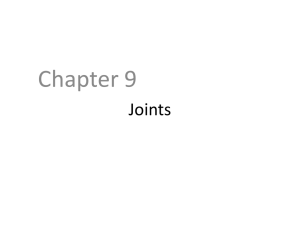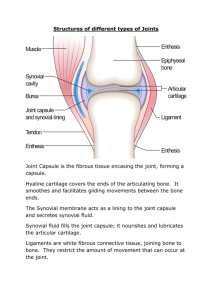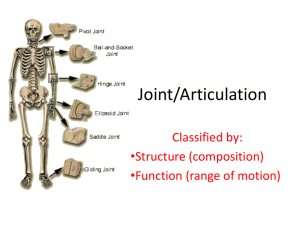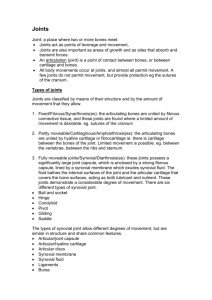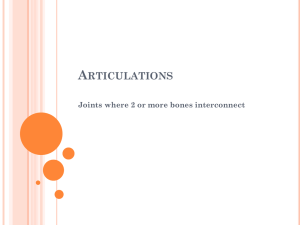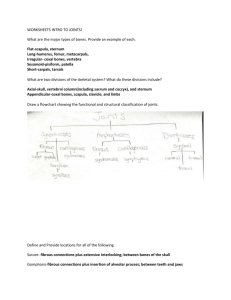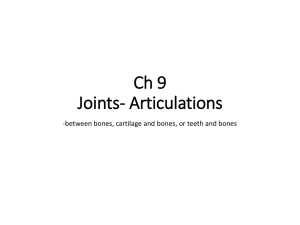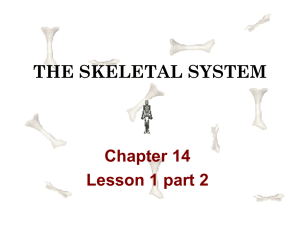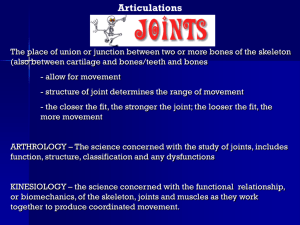Joints - Chapter 9
advertisement
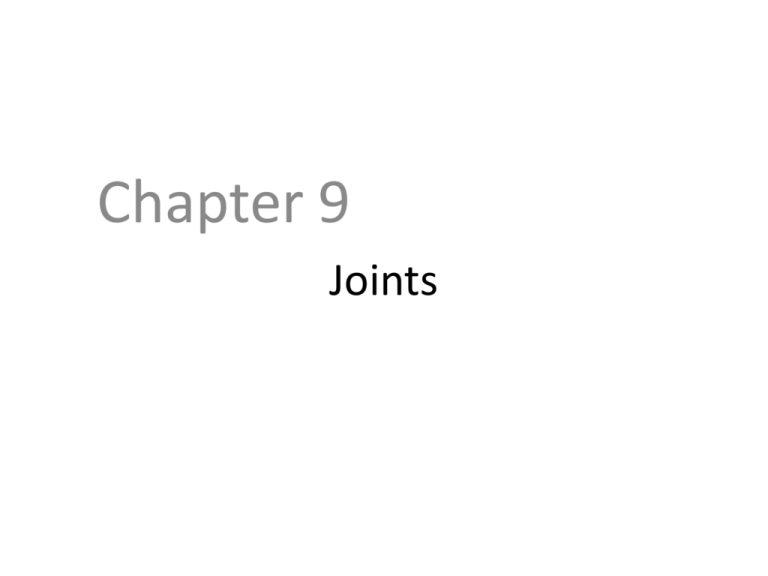
Chapter 9 Joints Objectives • Be able to define an articulation and arthrology • Know the four main categories of articulations and their sub categories • Know the various movements allowed by synovial joints • Be able to describe selected joints of the body Articulations • Any point where two bones meet • Arthrology – Science of joint structure, function, and dysfunction • Classified into four main categories – Bony • Synostosis • Immovable joint formed when two separate bones fuse to form one • Ex. Frontal, mandible, epiphyseal line – Fibrous – Cartilaginous – Synovial Fibrous • Synarthrosis • Adjacent bones bound by collagen fibers that penetrate into both bones pc.maricopa.edu • Three kinds – Sutures • Serrate, lap, and plane – Gomphoses • Teeth in socket – Syndesmoses • Bones held by longer collagen fibers that allow for a greater range of motion – Interosseous membrane between ulna and radius Cartilaginous • Amphiarthrosis • Two bones are linked by cartilage • Two types – Synchondroses • Bones joined by hyaline cartilage – Epiphyseal discs – Symphysis • Bones are joined by fibrocartilage – Pubic symphysis, intervertebral discs Synovial Joints • Diarthrosis • Articulation of bones surrounded by a joint capsule – Articular hyaline cartilage at ends of bones – Synovial fluid – Articular disc and meniscus – Bursa and tendon sheaths • Exhibit the widest range of motion zoology.ubc.ca Classes of Synovial Joints • Six types based on shape of articular surface and degree of mobility – Ball and socket • Shoulder and hip joints • Wide range of motion – Condylar (ellipsoid) • Radiocarpel joint, metacarpophalangeal – Saddle • Trapezialmetacarpal joint • Sternoclavicular joint – Plane (gliding) • Carpals and tarsals, vertebral articular processes – Hinge • Knee and elbow – Pivot • Atlantoaxial and radioulnar joints iupucbio2.iupui.edu Movements of Synovial Joints • Flexion and extension • Abduction and adduction • Elevation and depression • Protractions and retraction • Circumduction • Rotation • Pronation and supination The Shoulder Joint • Glenohumoral joint • Shallow joint, allows wide range of motion – Glenoid labrum • Tendon of long head of bicep brachii aftabphysio.blogspot.com • Rotator cuff – Tendons of muscles • Five principal ligaments – Glenohumeral (3) – Coracohumeral – Transverse humeral aidmypain.com The Knee Joint • Tibiofemoral joint • Two intracapsular ligaments – Acl, pcl • Two extracapsular ligaments – Lateral collateral, medial collateral • Two menisci – Lateral and medial badknees.net The Ankle Joint • Talocrural joint – Two articulations • Tibia and talus • Fibula and talus • Anterior and posterior tibiofibular ligaments – Binds tibia to fibula • Medial (deltoid) ligament – Binds tibia to foot • Lateral (collateral) ligaments – Bind fibula to foot medical-dictionary.thefreedictionary.com cedars-sinai.edu chiropractic-books.com
